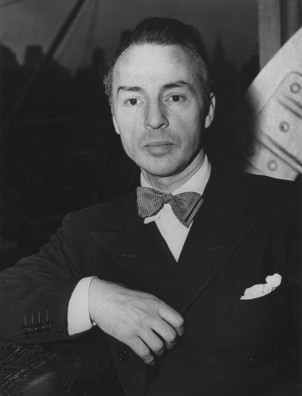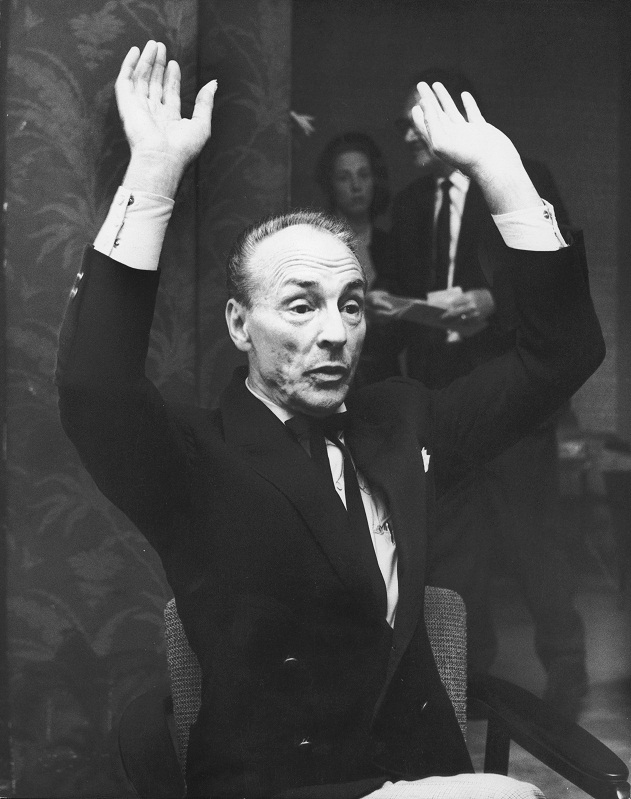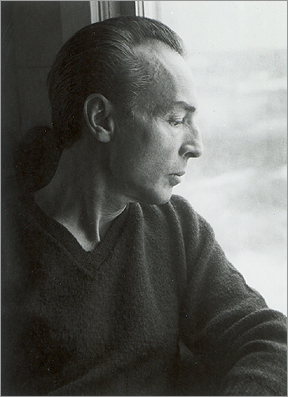<Back to Index>
- Choreographer George Balanchine, 1904
PAGE SPONSOR



George Balanchine (January 22, 1904 – April 30, 1983), born Giorgi Balanchivadze (Georgian: გიორგი ბალანჩივაძე) in Saint Petersburg, Russia, to a Georgian father and a Russian mother, was one of the 20th century's most famous choreographers, a developer of ballet in the United States, co-founder and ballet master of New York City Ballet. He was a choreographer known for his musicality; he expressed music with dance and worked extensively with Igor Stravinsky. Thirty - nine of his more than 400 ballets were choreographed to music by Stravinsky.
Balanchine's family comprised largely composers and soldiers. His father was the noted Georgian composer Meliton Balanchivadze (1862 – 1937), one of the initiators of the Georgian Opera. George's brother, Andria Balanchivadze (1906 – 1992), became a well known Georgian composer. As a child, Balanchine was not particularly interested in ballet. His mother loved the arts and had the young Giorgi audition with his sister, who shared her mother's passion for ballet.
Based on his audition, during 1913 (at age nine) Balanchine relocated from rural Finland to Saint Petersburg and was accepted into the Imperial Ballet School, principal school of the Imperial Ballet, where he was a student of Pavel Gerdt and Samuil Andrianov (Pavel's son - in - law). After the Bolsheviks won the Russian Revolution of 1917, they closed and disbanded the school as an elitist symbol of the Czarist regime. To survive the privation and martial law of this period, Balanchine played the piano — for food, not for money — at cabarets and silent movie theaters. Eventually the Imperial Ballet School reopened, but with greatly reduced funding from the government. After graduating with honors in 1921, Balanchine enrolled in the Petrograd Conservatory while working in the corps de ballet at The State Academic Theater for Opera and Ballet (formerly the State Theater of Opera and Ballet and known as the Mariinsky Ballet). His studies at the conservatory included advanced piano, music theory, counterpoint, harmony, and composition. Balanchine graduated from the conservatory during 1923, and danced as a member of the corps until 1924.
While still in his teens, Balanchine choreographed his first work, a pas de deux named La Nuit (1920, music by Anton Rubinstein). This was followed by another duet, Enigma, with the dancers in bare feet rather than ballet shoes. During 1923, with fellow dancers, Balanchine formed a small ensemble, the Young Ballet. The choreography proved too experimental for the new authorities.
In 1922, when Balanchine was eighteen years old, he married Tamara Geva, a fifteen year old dancer. After his divorce from Geva, Balanchine was with Alexandra Danilova from 1926 through 1933. He married and divorced three more times, all to women who were his dancers: Vera Zorina (December 1938 – 1946), Maria Tallchief (1946 – 1952), and Tanaquil LeClercq (1952 – 1969). He did not have any children.
On a 1924 visit to Germany with the Soviet State Dancers, Balanchine, his wife Tamara Geva, and the dancers Alexandra Danilova, and Nicholas Efimov fled to Paris, where there was a large Russian community of families exiled by the Revolution. The impresario Sergei Diaghilev, another Russian exile, asked Balanchine to join his newly formed Ballets Russes as a choreographer. Diaghilev drew from all the contemporary arts to create a company with great influence.
Diaghilev soon promoted Balanchine to ballet master of the company and promoted his choreography. Between 1924 and Diaghilev's death during 1929, Balanchine created nine ballets, as well as lesser works. During these years, he worked with major composers, such as Prokofiev, Stravinsky, Claude Debussy, Erik Satie and Ravel, and artists who designed sets and costumes, such as Pablo Picasso, Georges Rouault, and Henri Matisse, creating new works that combined all the arts. Among his new works, during 1928 in Paris, Balanchine premiered Apollon musagète (Apollo and the muses) in a collaboration with Stravinsky; it was one of his most innovative ballets, combining classical ballet and classical Greek myth and images with jazz movement. He described it as "the turning point in my life".
Suffering a serious knee injury, Balanchine had to limit his dancing, effectively ending his performance career. After Diaghilev's death, the Ballets Russes became somewhat disorganized. To earn money, Balanchine began to stage dances for the Cochran Revues in London. He was retained by the Royal Danish Ballet in Copenhagen as a guest ballet master.
When part of the Ballets Russes settled in Monte Carlo, Balanchine joined them and accepted a job as ballet master; directed by René Blum, the company was then named the Ballets Russes de Monte Carlo. He choreographed three ballets: Cotillon, La Concurrence, and Le Bourgeois Gentilhomme. His paramour in Monte Carlo was the young Tamara Toumanova, one of the original three "Baby Ballerinas" which the director had selected from the Russian exile community of Paris.
When Blum gave control of the company to Colonel W. de Basil, Balanchine left the Ballets Russes de Monte Carlo to act as principal choreographer for the newly founded Les Ballets 1933. The company was financed by Edward James, a British ballet patron. Boris Kochno, Diaghilev's former secretary and companion, served as artistic advisor. The company lasted only a couple of months during 1933, performing only in Paris and London, when the Great Depression made arts more difficult to fund. Balanchine created several new works, including collaborations with composers Kurt Weill, Darius Milhaud, and Henri Sauguet, and designer Pavel Tchelitchew.
Lincoln Kirstein,
a young American arts patron recently graduated from Harvard
University, saw Les Ballets 1933. With the goal of establishing a ballet
company in the United States, he met with and quickly persuaded
Balanchine to relocate there with his assistance. By October of that
year, Kirstein had brought Balanchine to New York, where he would begin
influencing the character, training and techniques of American ballet
and dance.
Balanchine insisted that his first project would be to establish a ballet school because he wanted to develop dancers who had the strong technique and style he wanted. Compared to his classical training, he thought they could not dance well. With the assistance of Lincoln Kirstein and Edward M.M. Warburg, the School of American Ballet opened to students on January 2, 1934, less than 3 months after Balanchine arrived in the U.S. Later that year, Balanchine had his students play a recital, where they premiered his new work Serenade to music by Tchaikovsky at the Warburg's summer estate. The work, modified by Balanchine over the years, remains a signature work of New York City Ballet nearly 80 years after its premiere.
Between his ballet activities in the 1930s and 1940s, Balanchine choreographed for musical theater with such notables as Richard Rodgers, Lorenz Hart and Vernon Duke. He greatly admired Fred Astaire, describing him as "the most interesting, the most inventive, the most elegant dancer of our times... you see a little bit of Astaire in everybody's dancing — a pause here, a move there. It was all Astaire originally."
During 1935, Balanchine formed a professional company named the American Ballet. After failing to organize a tour, the company began performing as the house company for the Metropolitan Opera. In 1936, Balanchine staged Gluck's opera Orfeo and Eurydice and during 1937 an evening of dance works all choreographed to the music of Igor Stravinsky.
Balanchine relocated his company to Hollywood during 1938, where he rented a white two - story house with "Kolya", Nicholas Kopeikine, his "rehearsal pianist and lifelong colleague", on North Fairfax Avenue not far from Hollywood Boulevard. Balanchine created dances for movies, some of which featured his wife Zorina and other of his dancers. He reconvened the company as the American Ballet Caravan and toured with it throughout North and South America, but it folded after several years. From 1944 to 1946, during and after World War II, Balanchine served as resident choreographer for the Ballet Russe de Monte Carlo.
Balanchine continued to work with contemporary composers, for example, setting The Four Temperaments to music of the same name by Paul Hindemith,
a composition which he commissioned in 1940. First performed on
November 20, 1946, the modernist work was one of his early abstract and
spare ballets, angular and very different in movement.
Soon Balanchine formed a new dance company, Ballet Society, again with the generous help of Lincoln Kirstein. After several successful performances, the most notable featuring the ballet Orpheus created in collaboration with Stravinsky and sculptor and designer Isamu Noguchi, the City of New York offered the company residency at the New York City Center. With that arrangement, Ballet Society officially became New York City Ballet in 1948.
In 1955, Balanchine created his version of The Nutcracker,
in which he played the mime role of Drosselmeyer. The company has since
performed the ballet every year in New York City during the Christmas season. One of its most famous productions, The Nutcracker has
been a money making tradition for NYCB and other companies that perform
it. It was filmed for theatrical release in 1993 by director Emile Ardolino, danced by NYCB with specially written narration spoken by Kevin Kline and released on DVD by Warner Brothers Home Video.
When Lincoln Center for the Performing Arts was constructed, NYCB was offered the New York State Theater (renamed the David H. Koch Theater since 2008 when the billionaire made a donation of one hundred million dollars for major renovations). Balanchine collaborated with architect Philip Johnson in determining its design and finally had a theater large enough for the works he wanted to stage when the house opened in 1964. He often created large scale works there, from American themes and Broadway, such as Stars and Stripes for the premiere performance, to drawing from European traditions and music, such as his 1977 Vienna Waltzes, a lavishly designed one - hour ballet choreographed to music by Johann Strauss II, Franz Lehár, and Richard Strauss.
During the 1960s, Balanchine created and revised nearly forty ballets including in 1965 a rare foray into the genre of evening length story ballets, Don Quixote in which he played the title role. His created the lead female role for Suzanne Farrell, the young ballerina of whom he was greatly enamored at the time and for whom he would create many roles until the end of his career. Among the most notable is the Diamonds section of the plotless evening length three - act ballet Jewels to music of Tchaikovsky. Some ballerinas, including his former wife Maria Tallchief, quit the company, citing his obsession with Farrell as the reason. Balanchine obtained a Mexican divorce from then wife Tanaquil LeClercq during this time.
In the summer of 1972, a year after the death of Stravinsky, Balanchine staged another Stravinsky Festival, for which he choreographed several major new works including the "miracle" ballets Stravinsky Violin Concerto and Symphony in Three Movements, both of which premiered on June 18, 1972.
After years of illness, Balanchine died on April 30, 1983 in New York City of Creutzfeldt – Jakob disease, diagnosed only after his death. He first showed symptoms during 1978 when he began losing his balance while dancing. As the disease progressed, his equilibrium, eyesight and hearing deteriorated. By 1982, he was incapacitated. The night of his death, the company went on with its scheduled performance which included Divertimento No. 15 and Symphony in C at Lincoln Center. In his last years, Balanchine also suffered from angina and underwent heart bypass surgery.